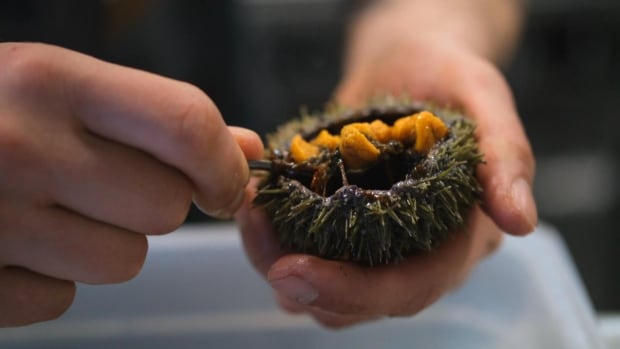Nicknamed the foie gras of the sea by some gastronomes, Quebec sea urchins will soon be available at dozens of restaurants across the province.
The delicacy will be served throughout the months of October and November as part of a new initiative by La Table Ronde, a collective of 110 restaurants in the province dedicated to developing the local gastronomy sector.
Known as Operation Sea Urchin, this pilot project aims to promote lesser-known marine products found in the Gulf of St. Lawrence, including sea urchins.
La Table Ronde is collaborating with the Wolastoqiyik Wahsipekuk First Nation of Cacouna for the project and 62 restaurateurs have decided to participate.
“Many species of fish that we pick in the St. Lawrence River, they are sent away for the international market, while when you eat fish in Quebec it’s mainly imported,” Félix-Antoine Joli-Cœur of La Table Ronde, said in an interview with Quebec AM.
Quebec AM8:59Operation Sea Urchin
Known as the foie gras of the sea, the sea urchin now has the backing of a collective of restauraurateurs in Quebec aiming to put more of them onto customers’ plates. Julia Caron spoke with Félix-Antoine Joli-Cœur, of La Table Ronde, about the strategy.
The group hopes to turn that trend around by allowing Quebecers to discover and enjoy local seafood, he said.
“For us, it just makes sense that the best of the best should also be available for us,” he said.
An international reputation

Every year, about 500 tonnes of sea urchins are fished in Quebec and most of them are exported abroad.
“They have the reputation to be the best on the international market,” said Joli-Coeur.
About 20 per cent of the province’s supply comes from the Wolastoqiyik Wahsipekuk First Nation of Cacouna, which usually ships its harvest to the United States.
But it is eager to diversify its market so when La Table Ronde reached out to the First Nation to see if it would sell its extra sea urchins to local restaurants, the project was born.
Sandra Gauthier, a facilitator in the project and the founder of Fourchette bleue, a certification program for the sustainable sourcing of marine resources in the St. Lawrence, said so far there has been a lot of interest from the domestic market.

Sustainable industry
Sea urchin fishing is “extremely sustainable and doesn’t threaten the seabed because it’s done manually,” Gauthier said.
Joli-Coeur said the fishermen are certified and will collect the sea urchins one by one, making sure to pick only the adult ones.
“It’s not something that is removing the sand or anything like that, it’s really folks that go into the water and do that in a very, very respectful, traditional way,” he said.
“It’s unbelievable to see the quantity of sea urchins that you can collect by hand.”
The fishing season for sea urchins starts when the weather gets colder, said Gauthier. “The colder the water is in the St. Lawrence, the more it’s the season to eat sea urchins.”
Over the next few weeks the gonads — the reproductive glands, which are the only part that’s edible — will grow and the meat yield will be even greater, she said.

The foie gras of the sea
According to Chloé Ouellet, a chef from Matane, Que., in the Lower St. Lawrence region, the taste of sea urchins resembles that of other seafood but is slightly more iodized.
“What I love about the sea urchin is its texture, the creaminess of the gonad which is really unique,” she said.
Ouellet said she thinks most people are unaware that sea urchins are edible and live in the Gulf of the St. Lawrence. Still, she said they have a lot of gastronomic potential.
“If sea urchins are less known, it’s not because of their taste. It’s really because it’s a product that is harder to prepare,” she said. “You have to open it, wash it, rinse it … there is more preparation.”

For Joli-Coeur, sea urchins taste a bit like oysters, but “the texture is way less strange.”
He said now that chefs in Quebec have been able to secure much larger quantities of the seafood, they can be more creative with their recipes.
“They can innovate doing pasta, doing salads, doing all kinds of stuff,” he said. “With a little glass of wine, it’s just going to be the perfect mixture.”
What’s more, the ones that will be sold in the restaurants will be super fresh, he said.
“It is super high quality — so go and taste it.”
A first shipment of sea urchins left the Gros-Cacouna port in the Lower St. Lawrence region on Monday. Some participating restaurants received their first delivery Tuesday night.
The project will continue over the next couple of months. Other promotion campaigns of under-appreciated products, such as seaweed, could take place in the coming weeks, Gauthier said.


